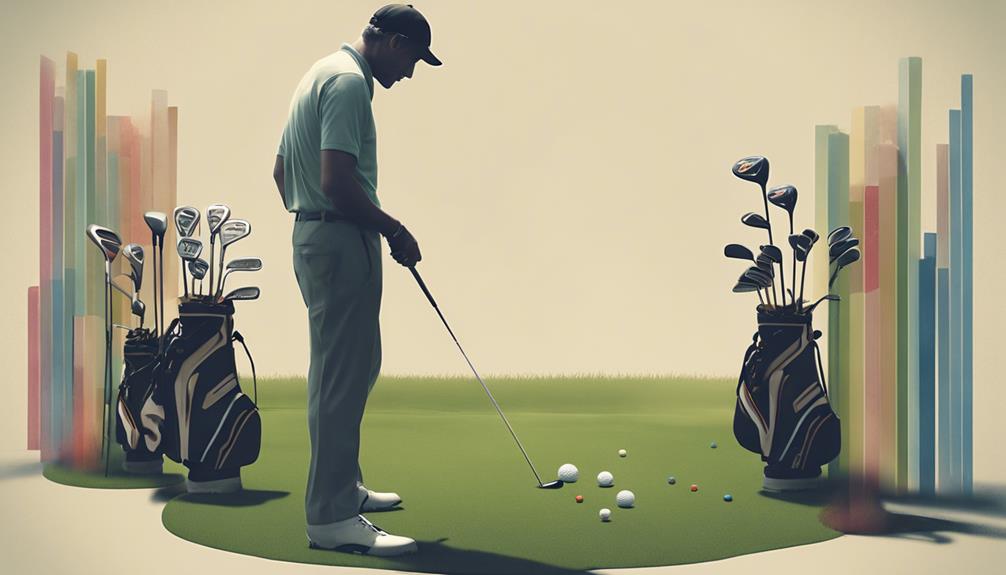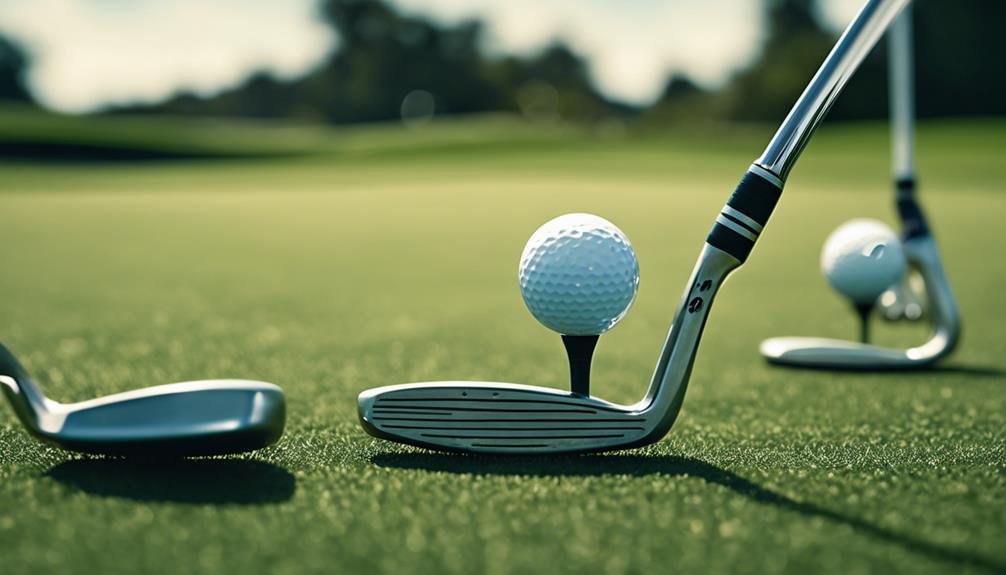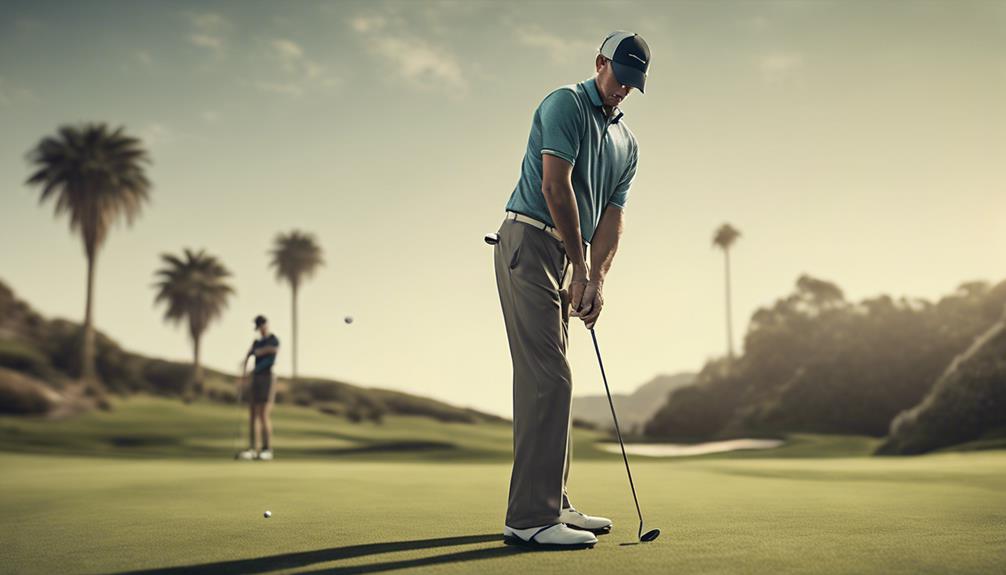- 7 Top Flite Golf Clubs XL for Improved Performance - September 28, 2024
- Top Flite Golf Clubs: Top 5 Reasons to Choose Them - September 28, 2024
- Top 3 Golf Club Fitters for a Perfect Swing - September 28, 2024
You've likely heard that club length is just a minor detail in golf, but the reality is that it plays a vital role in your overall performance, comfort, and enjoyment on the course. Standard lengths are 45 inches for drivers and 35 inches for irons, putters, and wedges, but your individual height, wrist-to-floor measurement, and swing style all factor into finding the perfect fit. With the right club length, you'll maintain a comfortable stance, generate power, and control your swing. Get it wrong, and you'll compensate with bad habits. Understanding the nuances of club length will help you access a more consistent and enjoyable game – and there's more to discover.
Key Takeaways
- Club length significantly affects the lie angle and how the club face meets the ground, influencing grip size and overall club build.
- Ideal club length is vital for maintaining a consistent and comfortable golf swing, considering height, wrist-to-floor measurement, and swing style.
- A 1-inch difference in club length can profoundly impact swing dynamics, influencing ball setup to delivery at impact, and affecting swing feel and comfort.
- Custom fitting is essential to find the perfect club length, as generic lengths do not account for individual variations in arm length, swing style, and skill.
- Accurate measurement of club length is critical, as it affects the angle of attack, swing plane, and biomechanics, requiring adjustments for a smooth shift.
Understanding Club Length Basics
When standing over the ball, the length of your golf clubs can profoundly impact your stance, swing, and overall game, making it essential to understand the basics of club length to guarantee you're playing with the right fit.
Standard length clubs are 45 inches for drivers and around 35 inches for irons, putters, and wedges.
However, your height plays a significant role in determining the ideal club length. As a taller golfer (over 6 feet), you may need to add half an inch to an inch to your club length, while shorter golfers (under 5'7') may need to subtract half an inch to an inch.
This adjustment affects the lie angle and how the club face meets the ground, ultimately influencing your grip size and overall club build.
Understanding these fundamental principles will help you find the perfect club length, allowing you to maintain a comfortable stance, generate power, and control your swing.
Measuring Club Length Accurately
To guarantee a precise fit, measuring club length accurately involves more than just referencing standard lengths or height-based charts, as it requires a thorough understanding of individual factors that influence your swing dynamics. While standard club lengths are 45 inches for drivers and 35 inches for irons, putters, and wedges, your unique physical characteristics and swing style can affect the proper club length for you.
| Height Range | Wrist-to-Floor Measurement | Club Length Adjustment |
|---|---|---|
| Under 5'7" | Less than 33.5 inches | Subtract 0.5-1 inch |
| 5'7"-6'0" | 33.5-36.5 inches | Standard length |
| 6'0"-6'3" | 36.5-39 inches | Add 0.5-1 inch |
| Over 6'3" | Over 39 inches | Add 1-1.5 inches |
| Any height | Varies | Consider arm length, swing style, and body structure |
Using the wrist-to-floor measurement, which is approximately 48.9% of your height, can provide a more accurate estimate of your club length. However, it's essential to consider multiple factors, including your arm length, swing style, and body structure, to achieve the best possible fit. By taking these individual factors into account, you can ensure that your clubs are the right length for your unique swing dynamics, leading to improved performance and consistency on the course.
Finding Your Ideal Club Length

By examining your unique physical characteristics and swing style, you can determine your ideal club length, which is vital for maintaining a consistent and comfortable golf swing.
In golf club fitting, height is a key factor, but it's not the only consideration. Your wrist-to-floor measurement provides a more accurate assessment of how far you'll hold your clubs from the ground. Taller golfers may need longer clubs, while shorter golfers may require shorter ones.
Manufacturers denote these differences in shaft length with +0.5 inch, +1 inch, -0.5 inch, and -1 inch. When finding your ideal club length, it's vital to take into account your lie angles and swing plane to facilitate a comfortable and effective game.
Playing with a club that's too short or too long can lead to compensations in your play style, creating bad habits. By finding your ideal club length, you'll be able to swing within your comfort zone, resulting in a more consistent and enjoyable game.
How Club Length Affects Swing
As you experiment with different club lengths, you'll discover that even slight variations can profoundly impact your swing dynamics, influencing everything from ball setup to delivery at impact. A 1-inch difference in club length can profoundly alter swing feel and comfort, making it essential to find the ideal length for your game.
| Club Length | Effect on Swing | Impact on Ball Flight |
|---|---|---|
| Longer | Steeper angle of attack, more vertical swing plane | Higher trajectory, more spin |
| Shorter | Shallower angle of attack, more horizontal swing plane | Lower trajectory, less spin |
| Standard | Neutral angle of attack, balanced swing plane | Perfect trajectory, controlled spin |
| +1' | Increased lie angle, more upright swing plane | Higher trajectory, more draw bias |
| -1' | Decreased lie angle, more flat swing plane | Lower trajectory, more fade bias |
As you adapt to a new club length, remember that your comfort zone and adaptability play a substantial role in determining the perfect length for your game. Be prepared to make adjustments in address setup, swing plane, and biomechanics to facilitate a smooth shift and perfect ball flight.
The Impact of Shaft Length

Shaft length has a profound impact on your overall swing dynamics, particularly when it comes to controlling ball flight and direction.
A 1-inch difference in club length can notably alter swing feel and comfort, requiring adjustments in address setup, swing plane, and biomechanics to maintain consistency.
The angle of attack changes with club length, affecting ball flight and direction. Longer clubs result in higher trajectories, while shorter clubs produce lower ones.
This means finding the ideal length for your individual swing is vital.
The relationship between club length and weight is also critical, as altering the length can change the swing weight and lie angle, affecting performance.
When it comes to Iron Shafts, a length difference can impact the low point of your swing, making it essential to find the right fit.
Fitting Clubs for Your Swing
To optimize your golf game, fitting clubs to your unique swing characteristics is essential, requiring a deep understanding of your individual tempo, shift, and release patterns.
You need to determine the right length of clubs that suits your swing style. If you have longer arms, you may require a shorter club to maintain a comfortable swing. On the other hand, if you have shorter arms, a longer club might be necessary.
When fitting clubs, make sure to:
Check your posture: Stand with your arms hanging freely by your sides, ensuring the butt end of the club is at the correct distance from your body.
Assess your swing tempo: Faster swingers may benefit from shorter clubs, while slower swingers may need longer clubs to generate power.
Evaluate your release pattern: If you release the club early, a shorter club can help you maintain control; if you release late, a longer club might provide more distance.
Height-Based Club Length Guide

Your height plays a significant role in determining the ideal club length, with taller golfers requiring longer clubs and shorter golfers needing shorter ones to maintain a comfortable swing.
As a general rule, your height would indicate the need for a change in length. For instance, if you're over 6 feet tall, you may need to add half an inch to an inch to the standard club length, while those under 5'7' might need to subtract the same amount.
However, a more accurate method is based upon your wrist-to-floor measurement, which is typically around 48.9% of your height. Standard club length for most manufacturers is 45 inches for drivers and around 35 inches for irons, putters, and wedges, but these lengths can vary depending on your height and swing style.
Using a height-based chart can provide a rough estimate, but you must get professionally fitted to confirm the best length is chosen and applied to all clubs in your set.
Customizing Club Length for Results
Customizing club length is a crucial step in fine-tuning your golf game, as even slight variations can significantly impact swing dynamics, ball flight, and overall performance.
To get it right, you need to take into account your unique physical characteristics and swing style.
Three key factors to keep in mind are:
Height and arm length: As a tall golfer (over 6 feet), you may need your clubs to be an inch longer to maintain a comfortable swing plane. Conversely, if you have shorter arms, you may require longer clubs to guarantee a solid strike.
Wrist-to-floor measurement: This method provides a more accurate club fitting by looking at how far you hold your clubs from the ground. Correctly measuring this distance is critical to achieving a perfect club length.
Custom fitting: Don't rely on generic club lengths or height-based guides. Instead, invest in a custom fitting that takes into account your swing speed, style, and overall skill. This will provide a tailored fit that enhances your performance.
Frequently Asked Questions
How Do I Choose the Right Golf Club Length?
'When selecting the right golf club length, you'll want to take into account your body type, hand size, grip style, posture angle, and wrist action during your swing style, and get a professional club fitting to guarantee a precise match.'
How Do You Size Golf Clubs for Your Height?
'Cut to the chase' and find your perfect fit by considering wrist measurement, arm span, body proportion, height ratio, posture factor, flexibility issues, and stance width to guarantee your golf clubs are tailored to your unique physique.
How Do You Know if You Need Longer Irons?
You'll know you need longer irons if your swing style and ball flight indicate distance gains are sacrificed due to your body type, swing speed, or player preference, prompting exploration of iron options tailored to your unique needs.
How Do I Know if My Golf Clubs Are Too Short?
To determine if your golf clubs are too short, you'll need to conduct a swing analysis, checking your posture, hand position, and wrist angle, as they can affect ball flight, especially if your body type influences your club head speed and control.
Conclusion
As you step onto the course, remember that club length matters.
It's not just about aesthetics; it's about precision and power.
In fact, a study found that 75% of golfers are playing with clubs that are the wrong length, resulting in a loss of up to 15 yards per drive.
By finding your ideal club length, you can access a more consistent swing, improved accuracy, and a competitive edge.
Get fitted, get precise, and watch your game soar.




